OK - General
The plant was discovered in 1841 by W. D. Brackenridge,
assistant botanist of the U.S. Exploring Expedition, in a
marsh a few miles south of Mt. Shasta in northern
California. John Torrey, a distinguished botanist of the 19th
century, recognized a close relationship to the
pitcher plants
in the East, yet a clear difference in floral
characteristics, and established a new genus in the pitcher
plant family, naming it
Darlingtonia californica,
in honor of his friend and botanist, William Darlington.*
The genus Darlingtonia is monotypic,
i.e.,
there is only one species in the genus.
The pitcher plant family Sarraceniaceae
includes two other genera, Sarracenia (eastern
North American pitcher plants) and Heliamphora (South American
pitcher plants).**
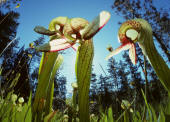 The cobra plant is a
herbaceous perennial consisting of a rhizome, with fibrous
roots. Tubular pitcher leaves arise directly from the
rhizome, forming a rosette. In this species, the hood of the
pitcher is well developed to form a dome, with the pitcher
opening facing downward. The pitcher lid is modified into a
two-lobed, fishtail-shaped appendage projecting downward from
the frontal edge of the opening. A peculiar feature of the
plant is that the leaves twist about one
half turn as they
grow. As a result, the pitcher openings tend to face
outward from the plant center. This conceivably provides
wider coverage for prey acquisition.
Based on my casual but numerous field observations, the direction of the
twist is just about even between clockwise and
counter-clockwise, though within a given
individual the direction is fixed.*** The cobra plant is a
herbaceous perennial consisting of a rhizome, with fibrous
roots. Tubular pitcher leaves arise directly from the
rhizome, forming a rosette. In this species, the hood of the
pitcher is well developed to form a dome, with the pitcher
opening facing downward. The pitcher lid is modified into a
two-lobed, fishtail-shaped appendage projecting downward from
the frontal edge of the opening. A peculiar feature of the
plant is that the leaves twist about one
half turn as they
grow. As a result, the pitcher openings tend to face
outward from the plant center. This conceivably provides
wider coverage for prey acquisition.
Based on my casual but numerous field observations, the direction of the
twist is just about even between clockwise and
counter-clockwise, though within a given
individual the direction is fixed.***
In a typical natural habitat, a mature pitcher leaf
stands between 40-60cm tall. Leaves reaching 100cm are found
in some low-light conditions. Seen in the field, the
overhanging hood of the pitcher leaf gives
the impression of
a deadly cobra poised to strike in imminent defense, hence
the common name. Other names for the plant include "cobra
lily" and "California pitcher plant".
The distribution of
cobra plants is limited to montane seeps
in northern California and the coastal
bogs along the adjacent western
part of Oregon. The colonies are
highly localized in characteristic marshy habitats often
with fresh, running waters.
OK - Habitat
Leaves of the cobra plant sprouting
out in the thousands on grass-covered slopes in the mountain
habitat -- with their cobra heads glowing in a golden hue --
offer a truly spectacular sight in nature.
Streams flowing through mountain
meadow create an ideal habitat for this remarkable species
of the pitcher plant family. Cold waters from the mountain
springs rush through a mild mountain slope in a sparsely
populated coniferous forest, forming a wide band of marshy
surface along the water path. It is in such an exacting
setup that the colonies of the cobra plants thrive. The
plants' fondness for this particular setup is clearly
seen / manifested in the astonishing similarity of many a montane
habitat throughout their range.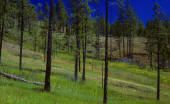
Many cobra plant sites are also known
to be located on or near serpentine rocks, providing
continuous stream flowing through serpentine rock formations
in the region. The soils in these
habitats are poor in nutrition, providing
a competitive advantage to the cobra plants possessing
a carnivorous lifestyle.
Many populations are found in the
montane habitats at an altitude of up to 2500m, although
some vigorous stands of cobra plants can be seen
a few feet above the sea level along the Oregon coast. The plants seem to be
tolerant to this climatic variation (Juniper, et al. 1989).
Rondeau recognizes two kinds of
primary habitats for Darlingtonia: A typical montane
habitat is what is duly described as a seep, often with a
moderate slope, having constant water flow on the soil
surface. The plants also grow in what can be described as "Darlingtonia
bogs", which are only found along the coastal plains in
Oregon, with near-zero slope, but with external water input
and drainage (Rondeau 1995).
As for accompanying carnivorous
plants, cobra plants are often found with Drosera
rotundifolia (round-leaf sundew) in
northern California and southwestern Oregon. There are
some colonies
in southern Oregon
where Pinguicula macroceras ssp.nortensis (butterwort) grows extensively alongside
Darlingtonia.
In summer, the daytime temperature may
reach 35 degrees Celsius in some localities. However, the
running water where the root is submerged rarely exceeds
mid-20 degrees Celsius on the same day. This constant supply
of cold water from mountain springs seems essential for the
healthy and vigorous growth of the cobra plant. The plants
are rarely seen in standing water in nature. Because of this
extreme intolerance to high temperature at the root, the
cobra plant is not a very easy plant to maintain in
cultivation. Even if you live within the perimeter of the
cobra plant's natural distribution in Oregon and California,
it is unlikely that you would have great success with
growing cobra plants if you just leave them in a
water-filled tray; you need to drop an ice cube or two on
the pot everyday during the hot summer days!
On the other hand, in the inland
localities of northern California, cobra
plants endure extremes of low temperature during the winter
months, sometimes covered with frost, ice, and snow!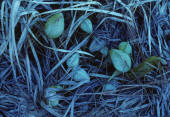
There is some debate as to which
direction the cobra plant colonies face. From field
observations, it is easy to see that Darlingtonia
enjoys plenty of sunlight. Plants growing in a sunny
location assume a colorful tint on the domed hood toward the
orifice and the fishtail appendage -- a definite advantage
in attracting prey -- that is absent in all-green, shade-grown
plants. Many major colonies
face south-east. Rondeau (1995) attributes this to local
hydrology of the region more than any
other factors. There are
many fine colonies in the mountain meadow whose slope is so
slight that it is rather academic to speak of colony
orientation (in relation to the amount of sunlight the
plants receive). And there are some colonies facing north.
We also find large colonies that are over-grown by
shrubberies and conifers, with rather limited sunlight,
regardless of their orientation. Darlingtonia seems
to persist well in those low-light conditions as long as
there is plenty of water supply, though the long-term health
of such colonies is uncertain.
OK - Rebecca M. Austin
Throughout the recorded history of
Darlingtonia, Rebecca Austin was the first to study the
plants in detail and make pioneering field work. (Juniper,
et al. 1989) Moving to northern California with her husband
and their three young children, Rebecca Austin was
fascinated by this unique California pitcher plant. Living
near great cobra plant sites, including Butterfly Valley
(now a protected nature preserve), she spent many days
observing the plants in the field, sometimes carrying her
sewing to the colony, even putting out a tent for overnight
observations. She also pursued her observation in the midst
of a violent thunderstorm, convincing herself that the
rainwater did not enter the pitcher. From 1875 to 1877, she
diligently communicated her detailed field observations to
W. M. Canby, a botanist in the East. Canby sent stationery
to help her work and encouraged her observations. The
then-newly-published book "Insectivorous
Plants" by Charles
Darwin was sent to her to aid her studies.
Rebecca Austin had already noted that the plants required
plenty of cold water for healthy growth.
Trap Structure and Attraction
The pitcher looks light
yellow-green on the domed hood and gets darker green toward the
base. The area around the pitcher opening
leading to the
fishtail appendage assumes a reddish coloration in plants
growing in the sun.
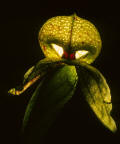 The basic trap structure of the
pitcher leaf is similar to that of the eastern pitcher
plants. Together with the attractive colors of the leaf,
prey is lured to the trap by nectar-secreting glands
scattered over much of the pitcher exterior.
To attract crawling
insects on the ground, there are nectar trails around the
pitcher tube leading to the pitcher opening. The basic trap structure of the
pitcher leaf is similar to that of the eastern pitcher
plants. Together with the attractive colors of the leaf,
prey is lured to the trap by nectar-secreting glands
scattered over much of the pitcher exterior.
To attract crawling
insects on the ground, there are nectar trails around the
pitcher tube leading to the pitcher opening.
The fishtail
appendage provides
a convenient landing site for flying insects. It is a
perfect feeding ground as well for the nectar secretionsis
abundant. Its surface is covered with short,
stiff hairs, pointing toward the pitcher opening.
This encourages the insect to ascend its way along the fishtail.
The dome and the upper part of the pitcher are scattered
with many areoles, called fenestrations. These patches are
completely void of chlorophyll and other pigments, forming
truly translucent windows. Seen against a blue sky, the
brightly lit ceiling of the dome
persuades the insect, already enjoying nectar on the
fishtail appendage, to venture into the dome interior.
The leaf edge of the orifice rolls inwards,
forming the “nectar roll” around the pitcher opening. This
is where the nectar production is most abundant.
Once inside, the fate of the insect is almost decided. The rolled-up
inner margin of the pitcher opening somewhat conceals the
true exit from insect's view, and
the light windows provide the illusion of false exits. The hooded dome interior is covered
with short, stiff hairs
(1 mm) all aligned in the direction toward the spiral tube. The
insect, instinctively seeking an exit in the direction of
light, often slams against the dome ceiling in its attempt
to fly through, and tumbles down into the spiral depth of
the cobra leaf.
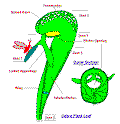 Right below the dome interior extends
a hairless, detachable waxy zone which offers an extremely
poor footing for the insect. Further down along the pitcher,
as the tube gets narrower, there grow long, intermeshing,
down-pointing hairs designed to prevent insect's ascent.
This retention zone continues almost to the end of the
pitcher. At the very bottom lies a short, smooth zone where
there is no glands. At the end of the summer
season, pitchers in the field
retain numerous exoskeletal
remains of insect bodies at the tube
base. Right below the dome interior extends
a hairless, detachable waxy zone which offers an extremely
poor footing for the insect. Further down along the pitcher,
as the tube gets narrower, there grow long, intermeshing,
down-pointing hairs designed to prevent insect's ascent.
This retention zone continues almost to the end of the
pitcher. At the very bottom lies a short, smooth zone where
there is no glands. At the end of the summer
season, pitchers in the field
retain numerous exoskeletal
remains of insect bodies at the tube
base.
A younger pitcher leaf tends to assume
a more tilted angle, with the forked appendage often
touching the ground. In this posture, the appendage serves
as a ladder leading to the pitcher opening for crawling
insects, such as ants.
OK -
Digestion and Absorption
The cobra plant normally retains small
amount of liquid at the bottom of the pitcher.
The well-developed domed hood
structure of the leaf all but precludes the possibility of
rainwater entering the pitcher. In Darlingtonia, an
unopened pitcher retains some liquid.
Unlike most species of the eastern
pitcher plants, the cobra plant does not possess
any digestive glands in the pitcher interior and no enzyme
secretions has ever been detected. The digestion of prey is
carried out solely with the aid of
externally introduced bacteria.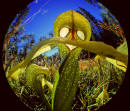
"In Darlingtonia", Juniper
et al. note, "which we consider to be a relatively
primitive carnivore in some respect, there are nectar
glands, but the glands of the digestive zone do not appear
to secrete enzymes. Thus, nectar secretionsmay have
developed before enzyme secretions in a species which relies
on a larval-protozon-bacterial chain breakdown for digestion
of prey. " Juniper et al. also note,
"...nectar secretionsmay more readily develop than enzyme
secretions because it was probably based initially on the
exudation of phloem contents already present, needing only
to become more concentrated. A mechanism was already present
in floral nectaries."
In spite of the
absence of enzyme production on the part of cobra plants, it
is a mistake to consider the trap merely a passive pitfall.
Studies have shown that a
certain chemical stimulation (like beef broth) precipitates
a large amount of fluid secretions into the pitcher.
The cobra plants
respond quickly to chemical stimulation as the result of
prey falling into the pitcher and actively causes a copious
increase of pitcher fluid, as reported by Austin and others,
in order to aid the digestion by bacteria.
The bottom part of the pitcher, where
the liquid is usually retained and where the digestion takes
place, does not possess any special glands. The permeability
of the inner wall due to cuticle discontinuity allows the
absorption of digestive material into the leaf tissue.
In the pitcher fluid, many white worms
are often found, apparently feeding on the captured prey.
This observation was first made by Rebecca Austin. I have made
similar observations. She
described it as "recently captured
insects rapidly covered with white 'worms' - hundreds of
such 'worms' in some tubes" (Juniper, et al). Rebecca
Austin also reported white larvae in unopened pitchers.
..... PHOTO of worms
OK- Inflorescence
In one of nature's most spectacular floral displays,
colonies of cobra plants throughout California and Oregon
are covered with eerie red flowers during the months of
early spring.
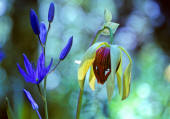 A flower bud forming in the rosette center
during the cold winter months develops into a tall scape, often reaching a height of 70-80cm
at the time of flowering. A red solitary
flower blooms in April-May in a pendulous position at the tip of
the tall scape. A flower bud forming in the rosette center
during the cold winter months develops into a tall scape, often reaching a height of 70-80cm
at the time of flowering. A red solitary
flower blooms in April-May in a pendulous position at the tip of
the tall scape.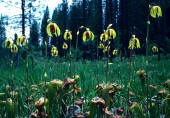
The dainty flower has five petals,
which hang from the base of the dangling flower. A
pale-yellow petal is heavily lined with red veins, making
the flower appear bright red. The tip of each petal
comes together to form a slightly elongated sphere. Each
petal has a small notch on each side two thirds of the way
down from the attached base. When the corolla sphere is
formed, each adjacent notch pair creates one circular
opening, five in all. Five elongated yellow sepals softly
overhang the red corolla. Inside the corolla
hangs a bell-shaped ovary
surrounded by 15 or so stamens. At the ovary base grows a
tiny, five-lobed stigma.
Just before the opening of
the flower, the sepals tightly fold the down-pointed
spherical corolla. PHOTO IF BUD
Upon
opening, as the sepals loosen, the anthers shed an ample amount of pollen. (The
anthers continue dehiscing pollen for 11-23 days, according
to Elder 1994). A slight tap of the flower causes the
massive amount of powderly pollen to fall out from the
corolla opening where petal tips meet. The flower appears to
be protandrous, that is, the stigma does not become
receptive initially. This is a common strategy seen in
flowering plants to avoid, or discourage, selfing.
In northern
California, flowering starts in early May and lasts for a
month. Red petals still remain on the flower for another few
weeks. When I visited
the site in early June, no pollen remained in the flower and
my attempt
to observe the corolla interior readily broke off the now
somewhat dry petals. In the same
habitat, a colony located in the shade appeared to be blooming
late by a few weeks compared with the population in the open, sunny location.
In southwestern Oregon, the bloom typically starts a few
weeks earlier than in California habitats, in mid-to-late
April, and continues through the month of May.
The age of the flowers are measured to be close to each other, a
phenomenon often interpreted to be a strategy against
unpredictable pollinators (Elder 1994). Also, Darlingtonia is one of
early bloomers of the field in northern California habitats,
possibly an attempt to avoid competition with other flowers
(Elder 1994).
One observation I
made is that the flower has a rather distinct smell, something of green vegetation freshly cut. It is
a pleasant scent, of a
fragrance of perfume, and fairly strong, too, for a freshly
opened flower. The scent lasts for a week or two.
Pollination
 An insect pollinator enters the
corolla through one of the five circular openings.
When the flower opens in a pendulous
position, the
five-lobed stigma projecting under the bell-shaped ovary is
located right at the same level as the circular openings.
This causes the pollinator to brush the stigma immediately upon
entry and deposit the pollen collected from the previously
visited flower. Fifteen or so stamens hang around the ovary
base inside the corolla. As the insect pollinator ascends in
the corolla interior in search of nectar, it now collects
pollen of that flower. When the insect is ready to leave the
flower, it does so by sliding down the ovary slope and
exiting the flower either through one of the circular
openings or by pushing the petal tips.
This way, it is unlikely the insect will touch the
stigma again -- which is somewhat hidden under the expanded
bottom of the bell-shaped ovary. This structure seems
to encourage cross-pollination by
reducing the chance of selfing. An insect pollinator enters the
corolla through one of the five circular openings.
When the flower opens in a pendulous
position, the
five-lobed stigma projecting under the bell-shaped ovary is
located right at the same level as the circular openings.
This causes the pollinator to brush the stigma immediately upon
entry and deposit the pollen collected from the previously
visited flower. Fifteen or so stamens hang around the ovary
base inside the corolla. As the insect pollinator ascends in
the corolla interior in search of nectar, it now collects
pollen of that flower. When the insect is ready to leave the
flower, it does so by sliding down the ovary slope and
exiting the flower either through one of the circular
openings or by pushing the petal tips.
This way, it is unlikely the insect will touch the
stigma again -- which is somewhat hidden under the expanded
bottom of the bell-shaped ovary. This structure seems
to encourage cross-pollination by
reducing the chance of selfing.
Though significantly
different in
appearance from the pitcher plant flowers of the East, a petal of
the cobra plant flower also has a tiny notch, as in Sarracenia
flower, both serving as a pollinator entrance. It is intriguing to speculate that this may suggest
some evolutionary
commonality between these two pitcher
plant genera belonging to the same family.
Elusive Pollinator
There is no field
report supporting the above pollinator scenario. It is
a common observation for those who have visited a colony in
September that countless scapes stand in the cobra field,
holding fruit
capsules filled with thousands of viable
seeds. 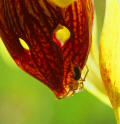 Whoever is responsible for the abundant crop of
seeds of the cobra plants, the unidentified pollinator somehow succeeded in
eluding discovery for the past 150 years. Whoever is responsible for the abundant crop of
seeds of the cobra plants, the unidentified pollinator somehow succeeded in
eluding discovery for the past 150 years.
Rebecca Austin, through her keen
observations, suspected the ever-ubiquitous spider to be a
pollinator of cobra plants. Many
observers after her witnessed spiders and their webs in the cobra plant flowers.
Indeed, it is often difficult to find a flower totally free
of spider web. This observation holds
true for both Oregon and California habitats.
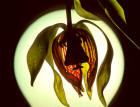 Schnell (2002) bets pollination
biologists will one day identify a bee to be the yet-unknown
pollinating agent for the cobra plants, as for Sarracenia
flowers in the East. Rondeau (1995) points out the total
lack of investigation on nocturnal creatures. Some
entomologist claims the unpleasant odor of the flower
clearly suggests pollination by flies (Rondeau 1995).**** Schnell (2002) bets pollination
biologists will one day identify a bee to be the yet-unknown
pollinating agent for the cobra plants, as for Sarracenia
flowers in the East. Rondeau (1995) points out the total
lack of investigation on nocturnal creatures. Some
entomologist claims the unpleasant odor of the flower
clearly suggests pollination by flies (Rondeau 1995).****
In April 6 though June
16, 1996, a research attempting to identify the pollinator
of the cobra plants
was conducted in Oregon (Nyoka 1999). Only a few sightings
of insects actually entering the flower have been recorded
during the daytime observations. Using sticky trap cards and
aerial netting in a large cobra plant colony in southwestern
Oregon, nearly 1800 flying insects have been captured and
analyzed. Of 27 species found to carry pollen, only 8
individual insects representing 4 species carried
Darlingtonia pollen. Ten of 14 arachnid species, totaling
some 80 individual spiders, collected in
and adjacent to the flowers were found to carry Darlingtonia
pollen. The report concluded
that the evidence of pollination by several insect species
was obtained, though noting the insect pollination may be
infrequent. The report also suggests that the spiders may be
playing a roll of pollinators for the plants.
Could the spiders be a
real (legitimate) agent of pollination for which the flower
has evolved over millennia? When it comes to cobra
plant flowers, delicate petals are twisted by the web,
sepals and bracts tied together, the stamens inside often
bundled together by the spider web. I have seen some flowers
where the stigma is completely shielded by the web. Many observers may feel
that this is not a matter of a flower-pollinator
arrangement. Rather, this is more like a case of massive spider infestation!
Virtually all flowers in the field are occupied by spiders.
It is way too risky to enter the flower. Yet-to-be-identified pollinators are prevented from
rendering the service because of the uninvited arachnid
visitors.
Is
the fertilization of the flower already completed by the
time the spider commandeers the flower? In 2004, I
attempted to answer this question. In early May in northern
California, flowering season had just started, as evidenced
by some flower buds among open flowers. I arrived at a
cobra plant colony very early in a morning. The flowers
were still covered with morning dews. The air was chilly. As
I looked around, almost all flowers were tendered by
spiders, sometimes three, four small spiders per flower. A
fierce web construction had already been well underway. On
one flower bud, I noticed a spider hiding under a bract near
the crooked scape, waiting for the flower to open. In a
matter of a week or so, no flowers would be free of webs. As
the sun rose, the spider activities subsided. Perhaps they
were hiding in the flower. Flies, bees, butterflies, and
dragonflies were seen, but none landed on the flower. As the
darkness enveloped the cobra plant blossom, moths started to
fly over the grassland. Many crane flies were also observed
near the water. I sat alone, being gazed at by hundreds of
silent, eerie red faces, in the darkness of the forest.
Every year, a couple of deer falls victim of the mountain
lion, a forest ranger had told me. No promising nocturnal
pollinators were observed on this day....
Conclusion
In the absence of
other creatures transporting pollen, at least not in
sufficient
frequency, do we have to conclude that the spiders are
indeed the major pollinators of the cobra plants? I am hard
pressed to accept this conclusion. If the
spiders are freely walking around inside the corolla, how is
it possible to avoid self-pollination? The unique floral
structure, coloration, fragrance... all these have evolved to attract spiders for their pollinating service?
Could it be that the
original insect pollinators have been chased away by the
massive invasion of spiders in the course of evolution? And,
as it turned out, the plants are benefiting from this
arrangement, as seen in the healthy crop of the seeds?
Glistening silver silk, blowing in the gentle
spring breeze, in the blossoming cobra plant colony tells us
the complexity of the ecosystem.
Germination & Growth
In nature, the seeds set by September.
A tall scape (that stands
80cm at the time of flowering) grows further after
fertilization as it straightens itself from pendulous to
erect posture, often reaching 100cm or more in height.
Each mature fruit capsule contains a large quantity of seeds
(1160 seeds on average, on unmanipulated flowers, and more
than 2000 if extra pollen added manually, according to Elder, 1994). A characteristic seed has numerous tiny
projections for animal dispersal. Floating seeds in the stream
may find new colonies down the stream.
Seed Stratification
The Darlingtonia
seeds require stratification. That is, the seeds
have to be exposed to low temperature before germination.
In nature, the seeds do not germinate until spring to prevent
the loss of new seedlings during the winter months.
One may find tiny
seedlings in the field with juvenile leaves which are
tubular with a narrow pointed tip.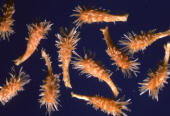 In cultivation, the seeds can be forced to germinate in the
same year by storing them in the refrigerator in a damp
medium for a few
weeks prior to sowing.
In cultivation, the seeds can be forced to germinate in the
same year by storing them in the refrigerator in a damp
medium for a few
weeks prior to sowing.
The cobra plant, for its size, is a
rather slow grower. After germination, it takes two to
three years for juvenile, hollow,
pointed-end leaves to assume the characteristics of a mature
pitcher. A few more years are required for the plant to
flower. The plant continues to grow, producing larger leaves
every ensuing year until it reaches its size maturity in
7-10 years from the seedling.
The cobra plant also shows vigorous
vegetative reproduction. The mature plant
sometimes produces another growth point in the rosette
center, eventually growing into two plants. In addition, the
plant habitually produces long underground runners,
or stolons. The tip of the stolon develops into
a new plant. This ability of the plant to reproduce
asexually often results in rather dense growth
characteristics as typically seen in the wild cobra plant
populations throughout their distribution.
OK - Pollinator/Prey Dilemma
A strange sense of similarity between
flower and trap of this species was felt by workers
observing the plants in the field. If this dual
attractiveness also extends to the insect world, a
pollinator/prey paradox may arise. Are the flower and the
pitcher designed to attract the same insects? If so, aren't
they competing for the same visitors to the plants, leading
to a potential pollinator/prey dilemma? Given the average
height of a mature pitcher leaf in the range of 40-60cm in
nature, a tall scape typically grows to 70-80cm in height.
This seems to offer some "spatial"
separation between pollination and prey-trapping zones.
Although varied depending on the locality and perhaps also
on the severity of the previous winter, field observations
show a relatively small number of functional traps remain at
the time of anthesis. This does offer a "temporary"
separation of a month or so for fertilization, before new
pitchers become fully grown and functional.
I have
seen some large colonies in Oregon where pitchers of the
previous season were well preserved into flowering,
though key attractants such as nectar and brilliant
coloration were not present.
Anthocyanin-Free Population
"Othello"
A population of anthocyanin-free
plants has been found in California (Elder
1994, Meyers-Rice 1997). The
flower has no red venation and is totally yellow. The
pitcher is also all-green to yellow, without any red
pigmentation. The plants are identical to the normal variety
in all other aspects. Meyers-Rice (1998) gave the plants
a cultivar, Darlingtonia californica "Othello". (The
cultivar is a "cultivated variety" that is registered with
an International Registration Authority, such as International
Carnivorous Plants
Society.)
Compass Plant
May blossoms
are soon to be
followed by a rush of fresh, green, tubular leaves shooting
up from the rosette center, signaling the onset of a
trapping season in the cobra plant country. These are the
first leaves of the season and are the tallest of all the leaves
to follow. PHOTO
It is Rebecca Austin who first
reported the compass nature of the cobra plant. She
observed that the plant always produced pitcher leaves in
pairs, a total of 10-18 new leaves each year. The first two
large leaves in the spring would face the north-south
direction, with the first leaf always being the tallest of
the year. The next two would emerge in the east-west
direction, thus, the first four pitchers of the season
pointing in the direction of the four major axes of the
compass. Some others confirmed her observations.
These four leaves stand far above all
the subsequent leaves.
Schnell (2002) noted his cultivated
plants obeyed this compass rule. He then turned the pot 90
degrees. The plants produced the leaves according to the old
orientation in the first year but adjusted to the new
orientation the following year.
My field observation confirmed this
compass tendency, though occasional violators have been
noted. It should be mentioned that it is
not always easy to distinguish individual plants in the
field especially when plants are forming a dense colony.
Also, since a Darlingtonia rhizome itself tends to
grow horizontally in one direction, which way the emerging
leaves are pointing to is sometimes not so clear. Incidentally, the emerging direction of the leaf
(presumably governed by the compass rule) and the characteristic "spin"
of the pitcher are two separate things. Thus, the final
orientation of the cobra head (or the direction the fishtail
appendage points to) is the sum of the initial leaf
direction and the leaf twist (which can
be 90-270 degrees, Rondeau 1995).
In Darlingtonia,
as noted by Rebecca Austin, all the leaves are not the same height.
Indeed, the leaf size within a given mature plant varies
dramatically, from full 40-60 cm at the tallest end all the way down to
less than a few inches. Unlike the pitcher plants in the
east which produce more or less the same sized adult leaves
from the rhizome, the cobra plant produces progressively
small er pitcher leaves during its yearly growth cycle. The
cobra plant produces the tall leaves early in the season,
and the subsequent leaves tend to be shorter than the
previous. The very first leaf to emerge right after
the flower is the tallest of the new season and the next one
the second tallest. (Based on the compass nature, this first
pair of leaves presumably point to the north-south
orientation.)
A field observation
I made in northern California in one spring, choosing a
mature, flower-bearing specimen, that was retaining the
previous year's pitchers fairly well, yielded the following.
==========
Total 19 leaves (prev
years) -
45,37,33,33,28,20,18,17,17,14,14,13,12,11,10,10,9,5,5.
New leaves 25 & 9
and the second bud 20 & 2.
Scape 60 cm
3 stolons - 40-50cm
long each -- each having 4,5 leaves of 3-7 cm high.
OK - Health of Habitat
Some of the large cobra plant habitats
are more than 150 years old. "One might expect that the
improvement of the soil, resulting from the sustained
capture of insects, would result in the competitive invasion
of more vigorous species.” Juniper et al. notes,
referring to the constant streams flowing on the soil
surface, "That this is not the case with Darlingtonia
may be due in part to the dynamic nature of its habitat,
forever removing the nutrient-rich humus that it produces.
In this respect, Darlingtonia differs from its
relative Sarracenia and many other carnivores which
continually destroy their own habitat."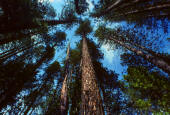
The rejuvenation benefit of
carnivorous plant habitats in general due to periodic,
naturally occurring fires is recognized by various authors.
Just as in the eastern pitcher plant habitats,
Darlingtonia also benefits from the natural fires in
their habitats. The low intensity
ground fire is said to pose little damage to the established
cobra plant colonies.
----
* See Rondeau
1995, for the history of how this unique plant from the West
was "named for a man who never saw it, never collected it,
and never even visited the golden state!".
** Some feel the three genera (Sarracenia,
Darlingtonia and Heliamphora) of New World
pitcher plants currently comprising the entire family
Sarraceniaceae are distinct enough, in terms of both floral
and vegetative structures, that the creation of the separate
families are warranted. (Also
see Phylogeny)
*** I have noted
that a plant from an underground stolon can have the
opposite twist. One large cobra plant I observed had
several runners, from the tip of which had emerged a new
young plant. Still connected to the parent plant by stolons,
two of them exhibited counter-clockwise twist while the rest
of the pack, including the parent, all have clock-wise leaf
twist. |












